When you can’t promise your patient 100 per cent recovery, giving them some hope won’t hurt

Rahul walked into my office with a limp. Not the kind where one leans off to a side in pain and needs the help of a stick or a crutch to support themselves. Here, he needed to raise his right leg high, almost as though he were climbing a step and bend the knee to take a step forward. He was unable to flex the ankle such that the heel makes contact with the ground before the rest of the foot does, which is how we normally walk; walking is such a subconscious activity that we barely realize it. Every time he took a step forward the foot came down with a slap to the ground like a blob. Surprisingly, he had no pain.
“When did this start?” I asked, after he settled his heavy frame down into a chair. He was in his early 40s and had curly biceps with tattoos of various Gods extending down to the forearm. I am always intrigued by people who have the ability to permanently ink themselves with a symbol, picture, quote, or anything else that seems relevant to their existence. I once had a patient who tattooed onto his back the screws and rods we placed inside his spine. I have also had the secret desire to tattoo my initials on the scalp of every brain tumour I remove, but I have vetoed that idea as my initials are MT, and when read aloud, would not be a good indicator of someone’s brain status.
“About six months ago,” he said, shuffling in his chair. “Initially it was very mild; I had some low-level back pain going down the leg, but that pain went away with some medication and I didn’t bother about it,” he proclaimed, clearly having taken charge of his own health. “What you had then is what we typically call sciatica,” I interjected. “But since the past 3 months, I just can’t seem to lift my right foot off the ground. I’ve been doing physiotherapy but it’s not helping.”
“Why did you wait for 3 months?” I asked, intrigued. He looked at me shaking his head sideways, not having an answer. “I guess I hoped it would settle down,” he said, trying to find himself an explanation. “Finally, I went to a neurologist, who examined me and said my nerve was damaged, which is what has caused the foot drop. He ordered an MRI and sent me to you,” he concluded, sounding frustrated. I asked Rahul to get up and walk, showing him how it was easy for him to walk on his toes, but that his knees buckled if he tried to walk on the heel. He just could not lift the heel up, and sensations along the distribution of the sciatic nerve in the right leg were diminished.
“The neurologist said that sometimes the nerve could be affected by diabetes or a vitamin deficiency, but not in my case,” he tried to explain. I am also always intrigued by patients’ interpretation of their previous doctors’ explanations, and he was doing a good job, although often, it’s more like Chinese whispers. I showed him on his MRI that there was a sizable disc prolapse in his lumbar spine between L4 and L5 that was compressing his nerve and flattening it out, which is why his neurologist had sent him to me.
“Ideally, this compression should be relieved by surgery, but I’m uncertain how much your foot will recover, because your nerve has stayed pressed for too long,” I confessed. “Then why do the operation if you can’t guarantee a cure?” he shot back, slightly hostile and understandably so. I went on to draw a few diagrams and explain on models that I have in my office (not the ones that walk the ramp but 3D acrylic specimens of the spine) that most often we operate for unrelenting pain, even though anecdotally, there are patients who miraculously improve on their own despite a foot drop. “When a weakness sets in, it’s best to do it at the earliest. If the nerve has been damaged beyond a point, sometimes even relieving the compression will not help it recover, but if you don’t remove the compression, it will almost certainly stay like this,” I went on. “In short, you’re telling me to get operated with no certainty of it changing anything,” he summarized. I nodded in agreement. “But my gut feeling is that it’ll help,” I added, trying to instil some faith. “I’ve done this on quite a few people in the exact same situation and even I have been surprised by the body’s ability to heal.” We shook hands and he left, slapping his foot as he walked away.
A few weeks later, he was on the operating table. We made an incision, half the size of a thumb, into his back and got to the space between L4 and L5. We cleanly drilled a bit of the bone and nibbled away at the ligament covering the dura. The nerve root that is usually round and thick was flattened and stretched like a pad Thai noodle. Angling the microscope and without stretching the nerve any further, we got into the disc space and removed a mammoth piece that sat there like the Rock of Gibraltar. We freed up the area all around the nerve to ensure that nothing else was pressing against it. “Do you think he’ll improve?” I asked my colleague assisting me while closing. Even if he’s uncertain, he’ll always say, “Yes, sir,” which is sometimes exactly what you need.
The next day, there was no change in his power in his right ankle, but Rahul said he was able to feel a different sensation in his foot. “As if there is some energy flowing through it,” he tried to explain. “I feel like there is some life to it!” he beamed. I discharged him and told him to continue the physiotherapy.
He came back to me 3 months later having completely recovered. He could walk on his toes and heels. His sensations had returned to normal. He was delighted. He had tattooed a photo of Zarathustra in a space left on his arm and showed it to me proudly. “Only the Parsi God was missing, but now, thanks to you, even he’s here!”
“Will you make a tiny tattoo of me on your foot?” I asked, being knowingly cheesy. “Then, every time you take a step, you will remember me,” I added, ever my filmy self. “You are already tattooed in my heart,” he smiled and gave me a tight hug, taking a selfie.




